brakes NISSAN ALTIMA 2005 L31 / 3.G Owners Manual
[x] Cancel search | Manufacturer: NISSAN, Model Year: 2005, Model line: ALTIMA, Model: NISSAN ALTIMA 2005 L31 / 3.GPages: 304, PDF Size: 4.91 MB
Page 83 of 304
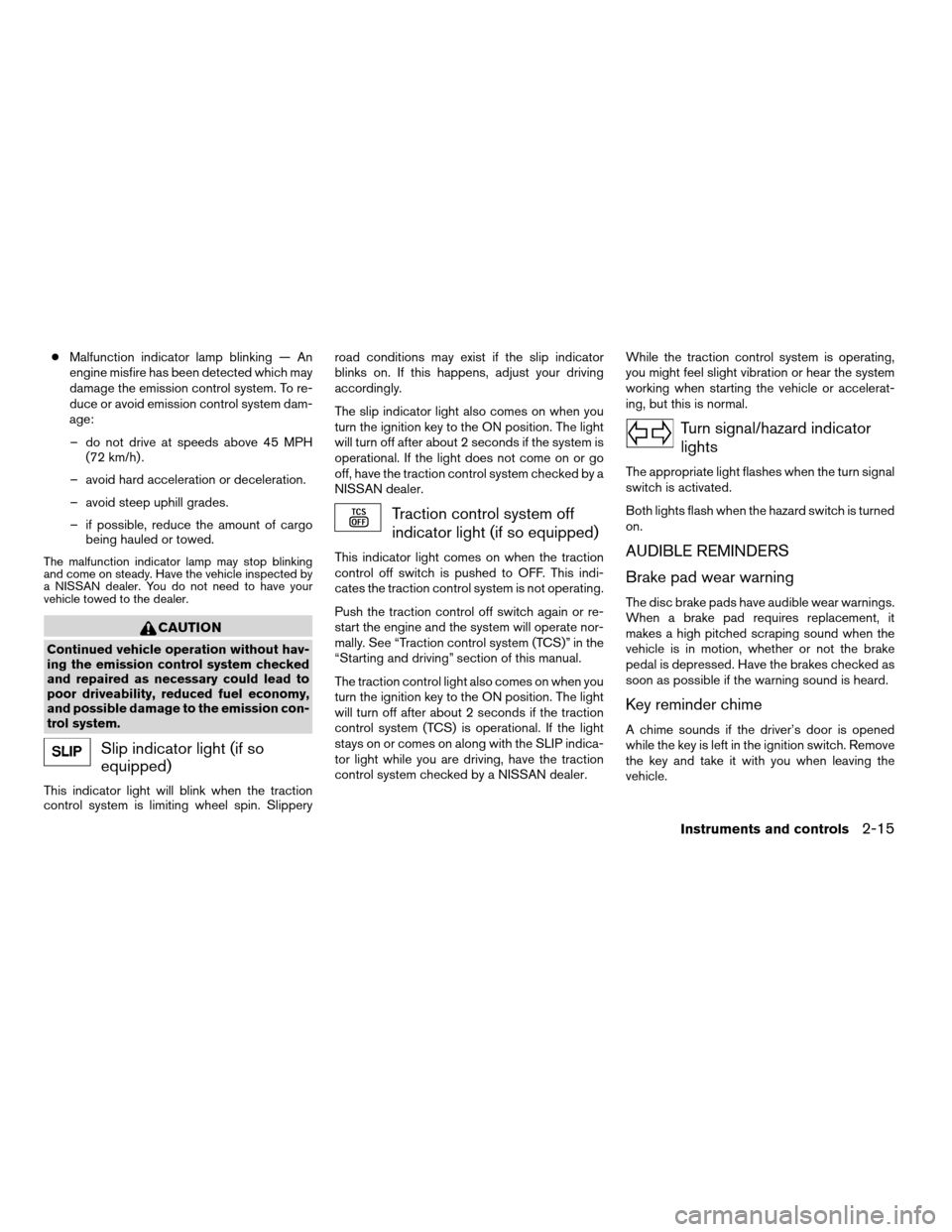
cMalfunction indicator lamp blinking — An
engine misfire has been detected which may
damage the emission control system. To re-
duce or avoid emission control system dam-
age:
– do not drive at speeds above 45 MPH (72 km/h) .
– avoid hard acceleration or deceleration.
– avoid steep uphill grades.
– if possible, reduce the amount of cargo being hauled or towed.
The malfunction indicator lamp may stop blinking
and come on steady. Have the vehicle inspected by
a NISSAN dealer. You do not need to have your
vehicle towed to the dealer.
CAUTION
Continued vehicle operation without hav-
ing the emission control system checked
and repaired as necessary could lead to
poor driveability, reduced fuel economy,
and possible damage to the emission con-
trol system.
Slip indicator light (if so
equipped)
This indicator light will blink when the traction
control system is limiting wheel spin. Slippery road conditions may exist if the slip indicator
blinks on. If this happens, adjust your driving
accordingly.
The slip indicator light also comes on when you
turn the ignition key to the ON position. The light
will turn off after about 2 seconds if the system is
operational. If the light does not come on or go
off, have the traction control system checked by a
NISSAN dealer.
Traction control system off
indicator light (if so equipped)
This indicator light comes on when the traction
control off switch is pushed to OFF. This indi-
cates the traction control system is not operating.
Push the traction control off switch again or re-
start the engine and the system will operate nor-
mally. See “Traction control system (TCS)” in the
“Starting and driving” section of this manual.
The traction control light also comes on when you
turn the ignition key to the ON position. The light
will turn off after about 2 seconds if the traction
control system (TCS) is operational. If the light
stays on or comes on along with the SLIP indica-
tor light while you are driving, have the traction
control system checked by a NISSAN dealer.
While the traction control system is operating,
you might feel slight vibration or hear the system
working when starting the vehicle or accelerat-
ing, but this is normal.
Turn signal/hazard indicator
lights
The appropriate light flashes when the turn signal
switch is activated.
Both lights flash when the hazard switch is turned
on.
AUDIBLE REMINDERS
Brake pad wear warning
The disc brake pads have audible wear warnings.
When a brake pad requires replacement, it
makes a high pitched scraping sound when the
vehicle is in motion, whether or not the brake
pedal is depressed. Have the brakes checked as
soon as possible if the warning sound is heard.
Key reminder chime
A chime sounds if the driver’s door is opened
while the key is left in the ignition switch. Remove
the key and take it with you when leaving the
vehicle.
Instruments and controls2-15
ZREVIEW COPYÐ2005 Altima
(l30)
Owners ManualÐUSA_English (nna)
06/28/04Ðtbrooks
X
Page 191 of 304
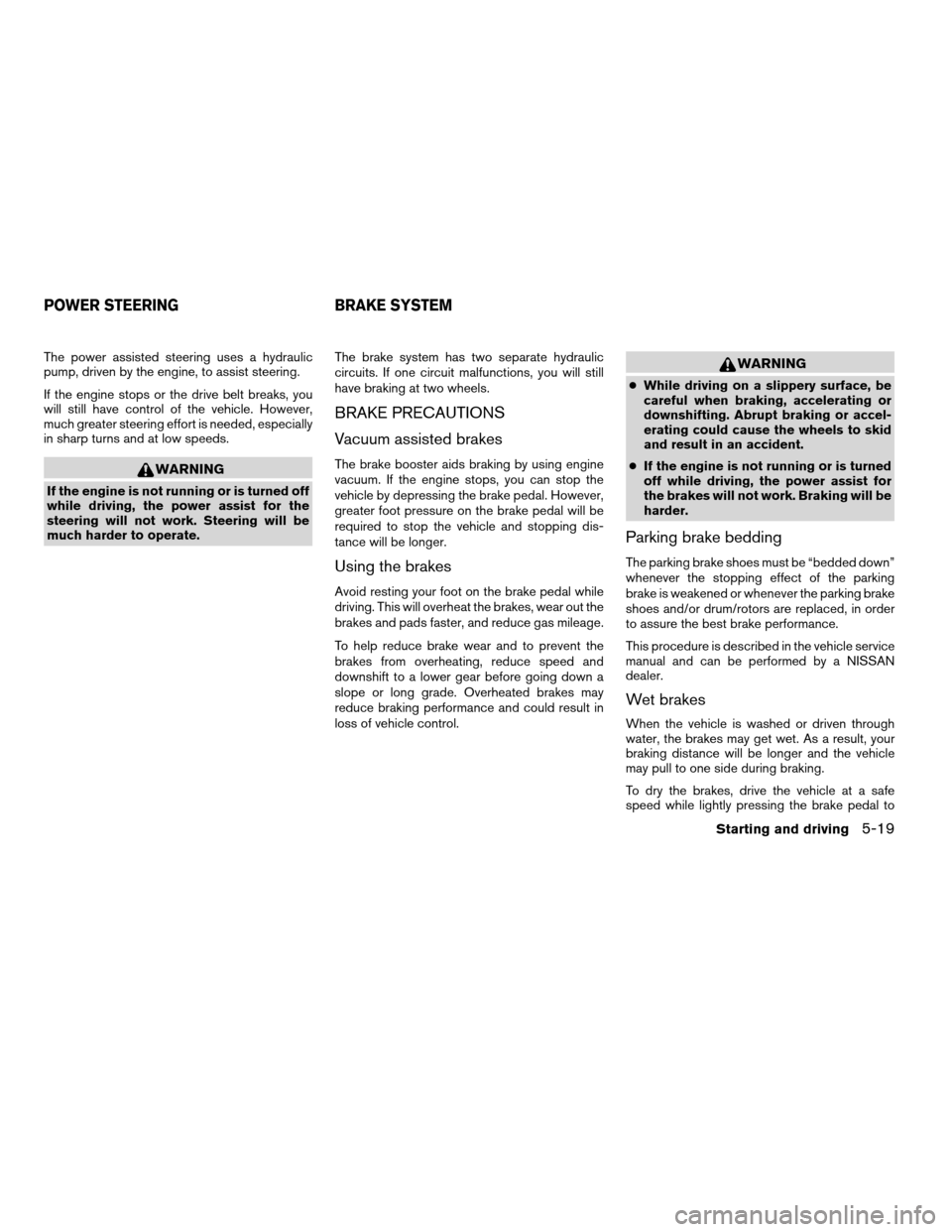
The power assisted steering uses a hydraulic
pump, driven by the engine, to assist steering.
If the engine stops or the drive belt breaks, you
will still have control of the vehicle. However,
much greater steering effort is needed, especially
in sharp turns and at low speeds.
WARNING
If the engine is not running or is turned off
while driving, the power assist for the
steering will not work. Steering will be
much harder to operate.The brake system has two separate hydraulic
circuits. If one circuit malfunctions, you will still
have braking at two wheels.
BRAKE PRECAUTIONS
Vacuum assisted brakes
The brake booster aids braking by using engine
vacuum. If the engine stops, you can stop the
vehicle by depressing the brake pedal. However,
greater foot pressure on the brake pedal will be
required to stop the vehicle and stopping dis-
tance will be longer.
Using the brakes
Avoid resting your foot on the brake pedal while
driving. This will overheat the brakes, wear out the
brakes and pads faster, and reduce gas mileage.
To help reduce brake wear and to prevent the
brakes from overheating, reduce speed and
downshift to a lower gear before going down a
slope or long grade. Overheated brakes may
reduce braking performance and could result in
loss of vehicle control.
WARNING
c
While driving on a slippery surface, be
careful when braking, accelerating or
downshifting. Abrupt braking or accel-
erating could cause the wheels to skid
and result in an accident.
c If the engine is not running or is turned
off while driving, the power assist for
the brakes will not work. Braking will be
harder.
Parking brake bedding
The parking brake shoes must be “bedded down”
whenever the stopping effect of the parking
brake is weakened or whenever the parking brake
shoes and/or drum/rotors are replaced, in order
to assure the best brake performance.
This procedure is described in the vehicle service
manual and can be performed by a NISSAN
dealer.
Wet brakes
When the vehicle is washed or driven through
water, the brakes may get wet. As a result, your
braking distance will be longer and the vehicle
may pull to one side during braking.
To dry the brakes, drive the vehicle at a safe
speed while lightly pressing the brake pedal to
POWER STEERING BRAKE SYSTEM
Starting and driving5-19
ZREVIEW COPYÐ2005 Altima (l30)
Owners ManualÐUSA_English (nna)
06/28/04Ðtbrooks
X
Page 192 of 304
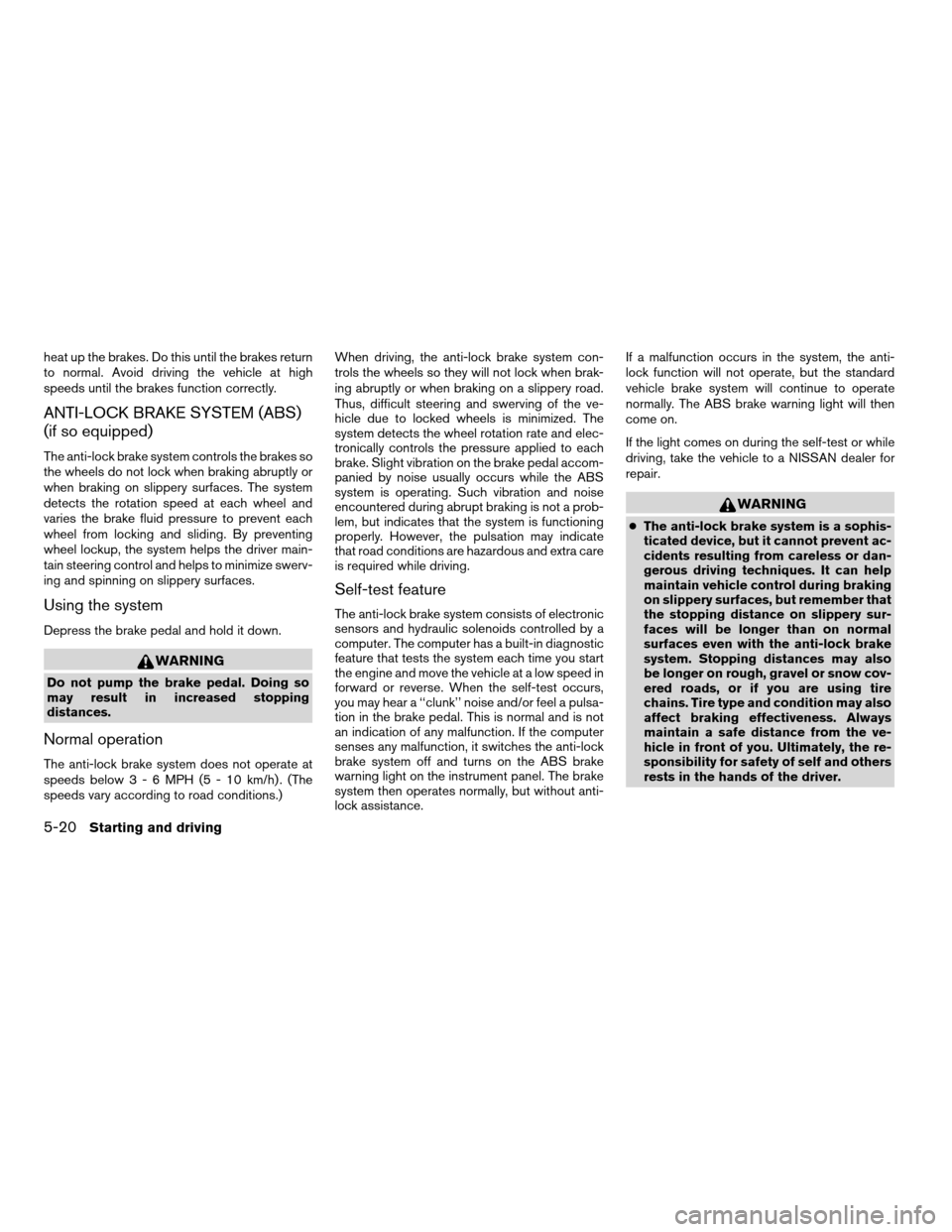
heat up the brakes. Do this until the brakes return
to normal. Avoid driving the vehicle at high
speeds until the brakes function correctly.
ANTI-LOCK BRAKE SYSTEM (ABS)
(if so equipped)
The anti-lock brake system controls the brakes so
the wheels do not lock when braking abruptly or
when braking on slippery surfaces. The system
detects the rotation speed at each wheel and
varies the brake fluid pressure to prevent each
wheel from locking and sliding. By preventing
wheel lockup, the system helps the driver main-
tain steering control and helps to minimize swerv-
ing and spinning on slippery surfaces.
Using the system
Depress the brake pedal and hold it down.
WARNING
Do not pump the brake pedal. Doing so
may result in increased stopping
distances.
Normal operation
The anti-lock brake system does not operate at
speeds below3-6MPH(5-10 km/h) . (The
speeds vary according to road conditions.) When driving, the anti-lock brake system con-
trols the wheels so they will not lock when brak-
ing abruptly or when braking on a slippery road.
Thus, difficult steering and swerving of the ve-
hicle due to locked wheels is minimized. The
system detects the wheel rotation rate and elec-
tronically controls the pressure applied to each
brake. Slight vibration on the brake pedal accom-
panied by noise usually occurs while the ABS
system is operating. Such vibration and noise
encountered during abrupt braking is not a prob-
lem, but indicates that the system is functioning
properly. However, the pulsation may indicate
that road conditions are hazardous and extra care
is required while driving.
Self-test feature
The anti-lock brake system consists of electronic
sensors and hydraulic solenoids controlled by a
computer. The computer has a built-in diagnostic
feature that tests the system each time you start
the engine and move the vehicle at a low speed in
forward or reverse. When the self-test occurs,
you may hear a ‘‘clunk’’ noise and/or feel a pulsa-
tion in the brake pedal. This is normal and is not
an indication of any malfunction. If the computer
senses any malfunction, it switches the anti-lock
brake system off and turns on the ABS brake
warning light on the instrument panel. The brake
system then operates normally, but without anti-
lock assistance.If a malfunction occurs in the system, the anti-
lock function will not operate, but the standard
vehicle brake system will continue to operate
normally. The ABS brake warning light will then
come on.
If the light comes on during the self-test or while
driving, take the vehicle to a NISSAN dealer for
repair.
WARNING
c
The anti-lock brake system is a sophis-
ticated device, but it cannot prevent ac-
cidents resulting from careless or dan-
gerous driving techniques. It can help
maintain vehicle control during braking
on slippery surfaces, but remember that
the stopping distance on slippery sur-
faces will be longer than on normal
surfaces even with the anti-lock brake
system. Stopping distances may also
be longer on rough, gravel or snow cov-
ered roads, or if you are using tire
chains. Tire type and condition may also
affect braking effectiveness. Always
maintain a safe distance from the ve-
hicle in front of you. Ultimately, the re-
sponsibility for safety of self and others
rests in the hands of the driver.
5-20Starting and driving
ZREVIEW COPYÐ2005 Altima (l30)
Owners ManualÐUSA_English (nna)
06/28/04Ðtbrooks
X
Page 219 of 304
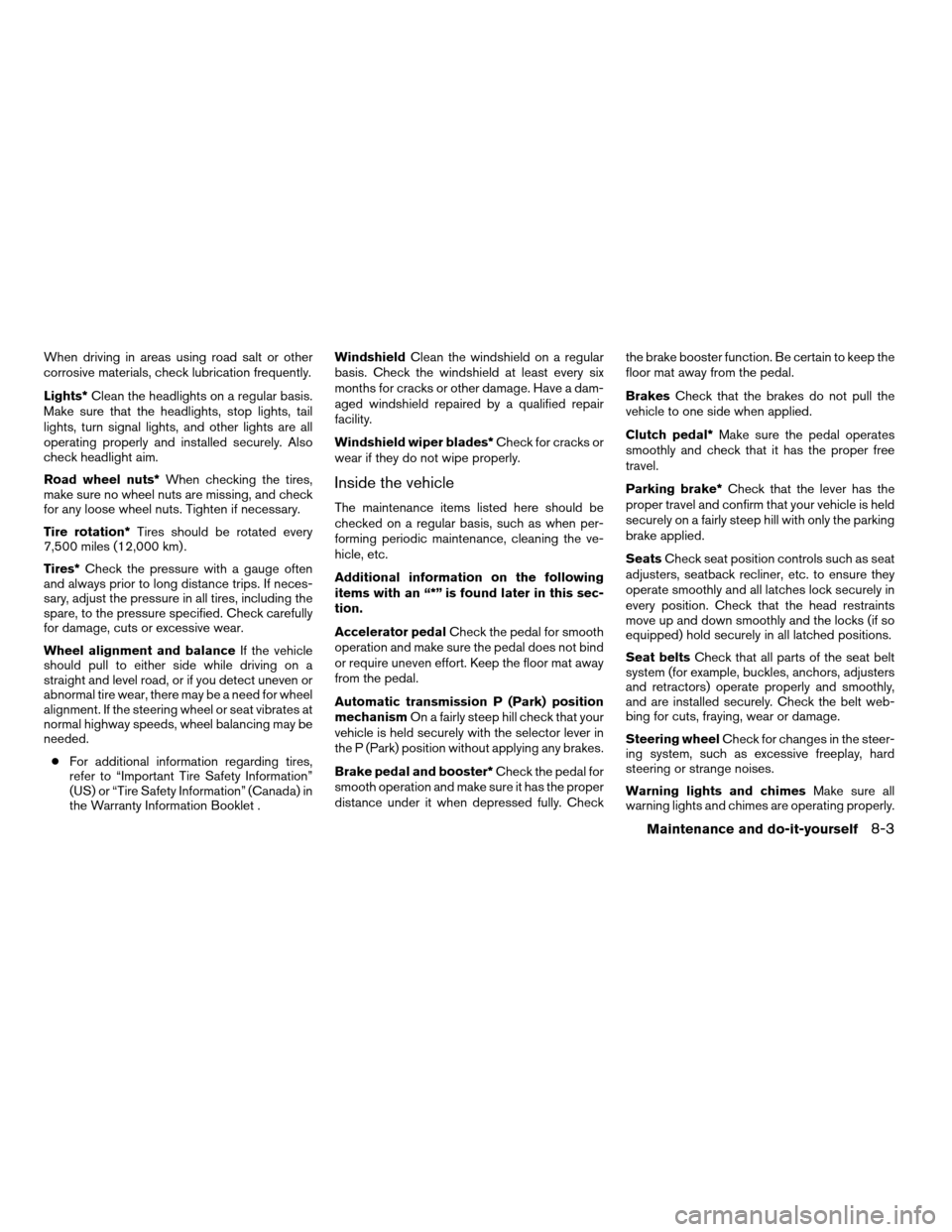
When driving in areas using road salt or other
corrosive materials, check lubrication frequently.
Lights*Clean the headlights on a regular basis.
Make sure that the headlights, stop lights, tail
lights, turn signal lights, and other lights are all
operating properly and installed securely. Also
check headlight aim.
Road wheel nuts* When checking the tires,
make sure no wheel nuts are missing, and check
for any loose wheel nuts. Tighten if necessary.
Tire rotation* Tires should be rotated every
7,500 miles (12,000 km) .
Tires* Check the pressure with a gauge often
and always prior to long distance trips. If neces-
sary, adjust the pressure in all tires, including the
spare, to the pressure specified. Check carefully
for damage, cuts or excessive wear.
Wheel alignment and balance If the vehicle
should pull to either side while driving on a
straight and level road, or if you detect uneven or
abnormal tire wear, there may be a need for wheel
alignment. If the steering wheel or seat vibrates at
normal highway speeds, wheel balancing may be
needed.
c For additional information regarding tires,
refer to “Important Tire Safety Information”
(US) or “Tire Safety Information” (Canada) in
the Warranty Information Booklet . Windshield
Clean the windshield on a regular
basis. Check the windshield at least every six
months for cracks or other damage. Have a dam-
aged windshield repaired by a qualified repair
facility.
Windshield wiper blades* Check for cracks or
wear if they do not wipe properly.
Inside the vehicle
The maintenance items listed here should be
checked on a regular basis, such as when per-
forming periodic maintenance, cleaning the ve-
hicle, etc.
Additional information on the following
items with an “*” is found later in this sec-
tion.
Accelerator pedal Check the pedal for smooth
operation and make sure the pedal does not bind
or require uneven effort. Keep the floor mat away
from the pedal.
Automatic transmission P (Park) position
mechanism On a fairly steep hill check that your
vehicle is held securely with the selector lever in
the P (Park) position without applying any brakes.
Brake pedal and booster* Check the pedal for
smooth operation and make sure it has the proper
distance under it when depressed fully. Check the brake booster function. Be certain to keep the
floor mat away from the pedal.
Brakes
Check that the brakes do not pull the
vehicle to one side when applied.
Clutch pedal* Make sure the pedal operates
smoothly and check that it has the proper free
travel.
Parking brake* Check that the lever has the
proper travel and confirm that your vehicle is held
securely on a fairly steep hill with only the parking
brake applied.
Seats Check seat position controls such as seat
adjusters, seatback recliner, etc. to ensure they
operate smoothly and all latches lock securely in
every position. Check that the head restraints
move up and down smoothly and the locks (if so
equipped) hold securely in all latched positions.
Seat belts Check that all parts of the seat belt
system (for example, buckles, anchors, adjusters
and retractors) operate properly and smoothly,
and are installed securely. Check the belt web-
bing for cuts, fraying, wear or damage.
Steering wheel Check for changes in the steer-
ing system, such as excessive freeplay, hard
steering or strange noises.
Warning lights and chimes Make sure all
warning lights and chimes are operating properly.
Maintenance and do-it-yourself8-3
ZREVIEW COPYÐ2005 Altima (l30)
Owners ManualÐUSA_English (nna)
06/28/04Ðtbrooks
X
Page 242 of 304
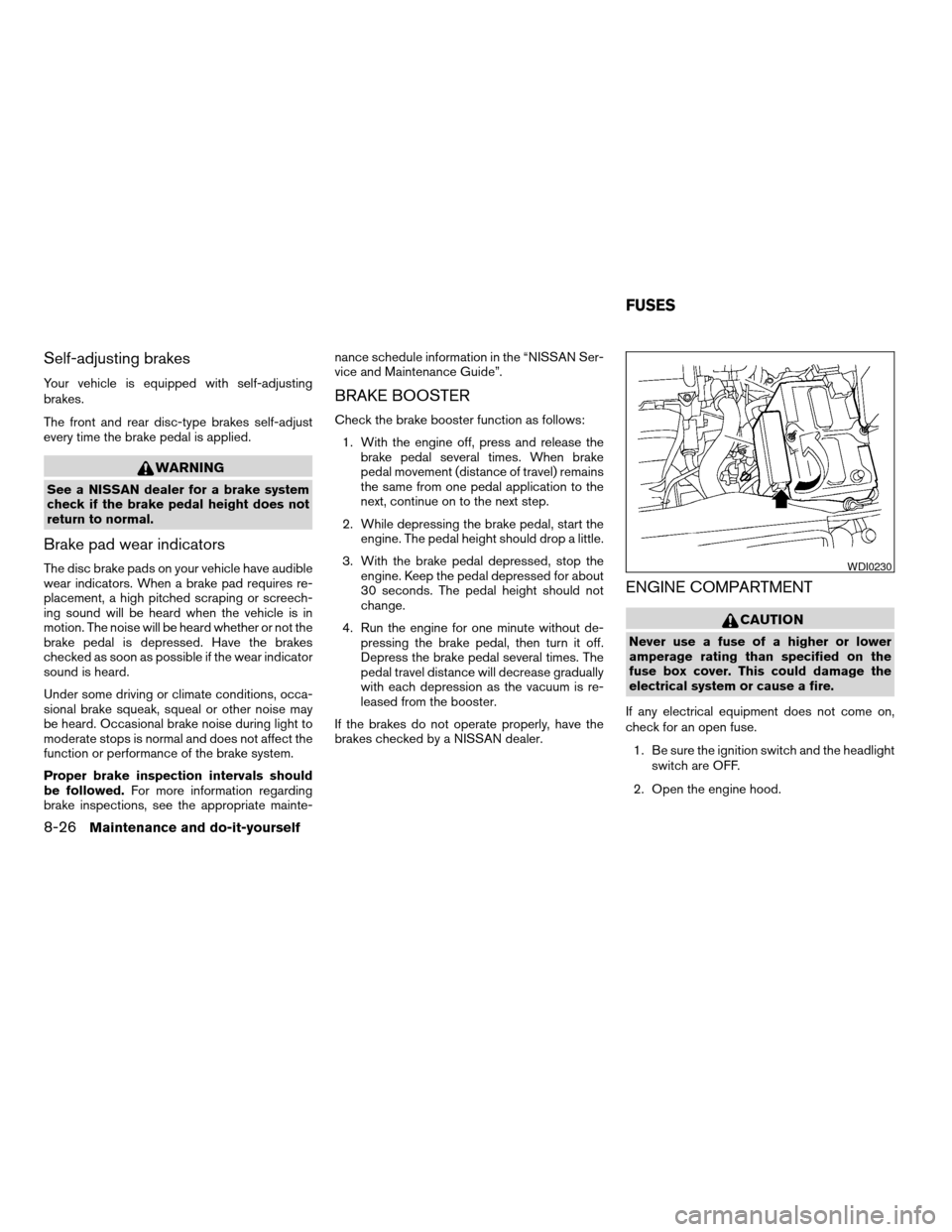
Self-adjusting brakes
Your vehicle is equipped with self-adjusting
brakes.
The front and rear disc-type brakes self-adjust
every time the brake pedal is applied.
WARNING
See a NISSAN dealer for a brake system
check if the brake pedal height does not
return to normal.
Brake pad wear indicators
The disc brake pads on your vehicle have audible
wear indicators. When a brake pad requires re-
placement, a high pitched scraping or screech-
ing sound will be heard when the vehicle is in
motion. The noise will be heard whether or not the
brake pedal is depressed. Have the brakes
checked as soon as possible if the wear indicator
sound is heard.
Under some driving or climate conditions, occa-
sional brake squeak, squeal or other noise may
be heard. Occasional brake noise during light to
moderate stops is normal and does not affect the
function or performance of the brake system.
Proper brake inspection intervals should
be followed.For more information regarding
brake inspections, see the appropriate mainte- nance schedule information in the “NISSAN Ser-
vice and Maintenance Guide”.
BRAKE BOOSTER
Check the brake booster function as follows:
1. With the engine off, press and release the brake pedal several times. When brake
pedal movement (distance of travel) remains
the same from one pedal application to the
next, continue on to the next step.
2. While depressing the brake pedal, start the engine. The pedal height should drop a little.
3. With the brake pedal depressed, stop the engine. Keep the pedal depressed for about
30 seconds. The pedal height should not
change.
4. Run the engine for one minute without de- pressing the brake pedal, then turn it off.
Depress the brake pedal several times. The
pedal travel distance will decrease gradually
with each depression as the vacuum is re-
leased from the booster.
If the brakes do not operate properly, have the
brakes checked by a NISSAN dealer.
ENGINE COMPARTMENT
CAUTION
Never use a fuse of a higher or lower
amperage rating than specified on the
fuse box cover. This could damage the
electrical system or cause a fire.
If any electrical equipment does not come on,
check for an open fuse. 1. Be sure the ignition switch and the headlight switch are OFF.
2. Open the engine hood.
WDI0230
FUSES
8-26Maintenance and do-it-yourself
ZREVIEW COPYÐ2005 Altima (l30)
Owners ManualÐUSA_English (nna)
06/28/04Ðtbrooks
X
Page 283 of 304
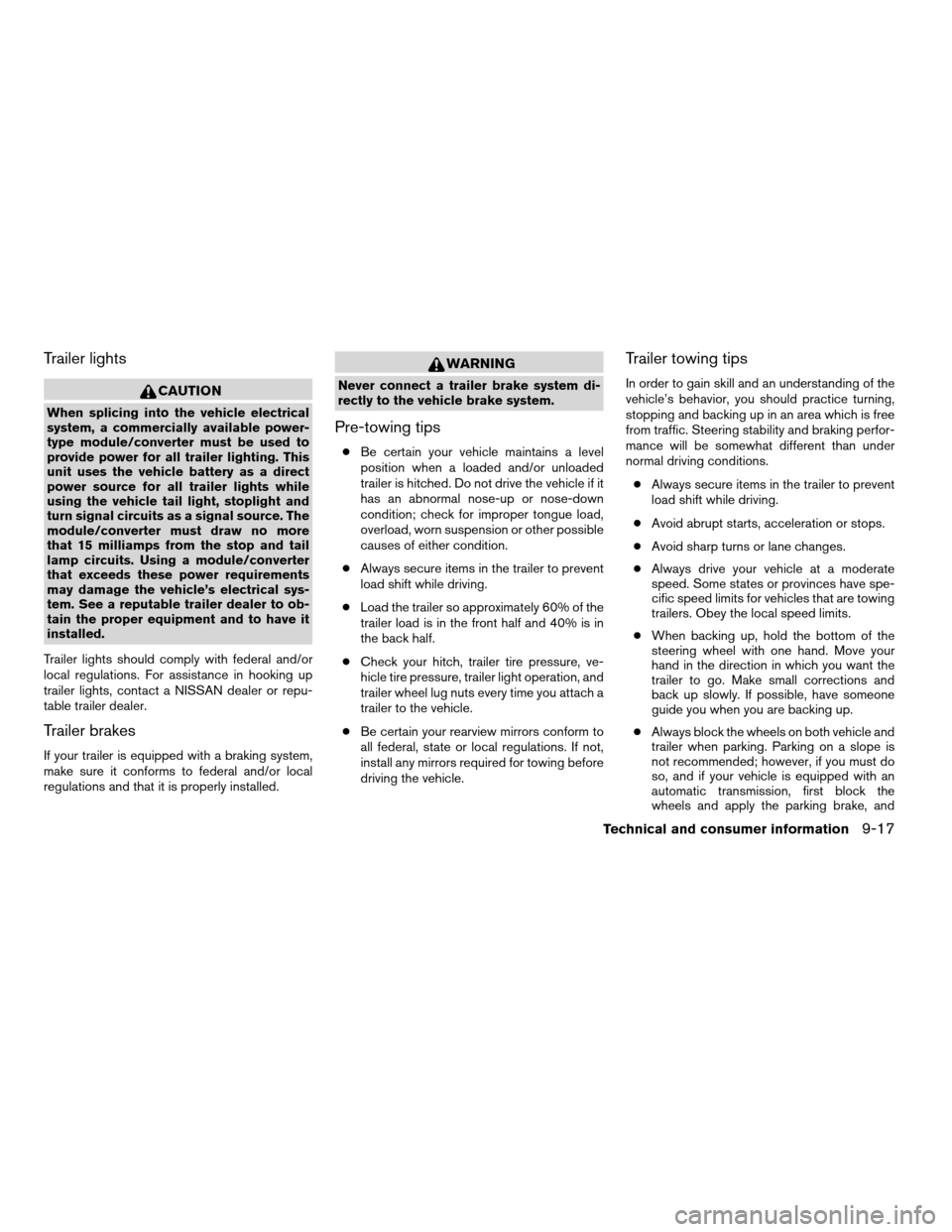
Trailer lights
CAUTION
When splicing into the vehicle electrical
system, a commercially available power-
type module/converter must be used to
provide power for all trailer lighting. This
unit uses the vehicle battery as a direct
power source for all trailer lights while
using the vehicle tail light, stoplight and
turn signal circuits as a signal source. The
module/converter must draw no more
that 15 milliamps from the stop and tail
lamp circuits. Using a module/converter
that exceeds these power requirements
may damage the vehicle’s electrical sys-
tem. See a reputable trailer dealer to ob-
tain the proper equipment and to have it
installed.
Trailer lights should comply with federal and/or
local regulations. For assistance in hooking up
trailer lights, contact a NISSAN dealer or repu-
table trailer dealer.
Trailer brakes
If your trailer is equipped with a braking system,
make sure it conforms to federal and/or local
regulations and that it is properly installed.
WARNING
Never connect a trailer brake system di-
rectly to the vehicle brake system.
Pre-towing tips
c Be certain your vehicle maintains a level
position when a loaded and/or unloaded
trailer is hitched. Do not drive the vehicle if it
has an abnormal nose-up or nose-down
condition; check for improper tongue load,
overload, worn suspension or other possible
causes of either condition.
c Always secure items in the trailer to prevent
load shift while driving.
c Load the trailer so approximately 60% of the
trailer load is in the front half and 40% is in
the back half.
c Check your hitch, trailer tire pressure, ve-
hicle tire pressure, trailer light operation, and
trailer wheel lug nuts every time you attach a
trailer to the vehicle.
c Be certain your rearview mirrors conform to
all federal, state or local regulations. If not,
install any mirrors required for towing before
driving the vehicle.
Trailer towing tips
In order to gain skill and an understanding of the
vehicle’s behavior, you should practice turning,
stopping and backing up in an area which is free
from traffic. Steering stability and braking perfor-
mance will be somewhat different than under
normal driving conditions.
c Always secure items in the trailer to prevent
load shift while driving.
c Avoid abrupt starts, acceleration or stops.
c Avoid sharp turns or lane changes.
c Always drive your vehicle at a moderate
speed. Some states or provinces have spe-
cific speed limits for vehicles that are towing
trailers. Obey the local speed limits.
c When backing up, hold the bottom of the
steering wheel with one hand. Move your
hand in the direction in which you want the
trailer to go. Make small corrections and
back up slowly. If possible, have someone
guide you when you are backing up.
c Always block the wheels on both vehicle and
trailer when parking. Parking on a slope is
not recommended; however, if you must do
so, and if your vehicle is equipped with an
automatic transmission, first block the
wheels and apply the parking brake, and
Technical and consumer information9-17
ZREVIEW COPYÐ2005 Altima (l30)
Owners ManualÐUSA_English (nna)
06/28/04Ðtbrooks
X
Page 284 of 304
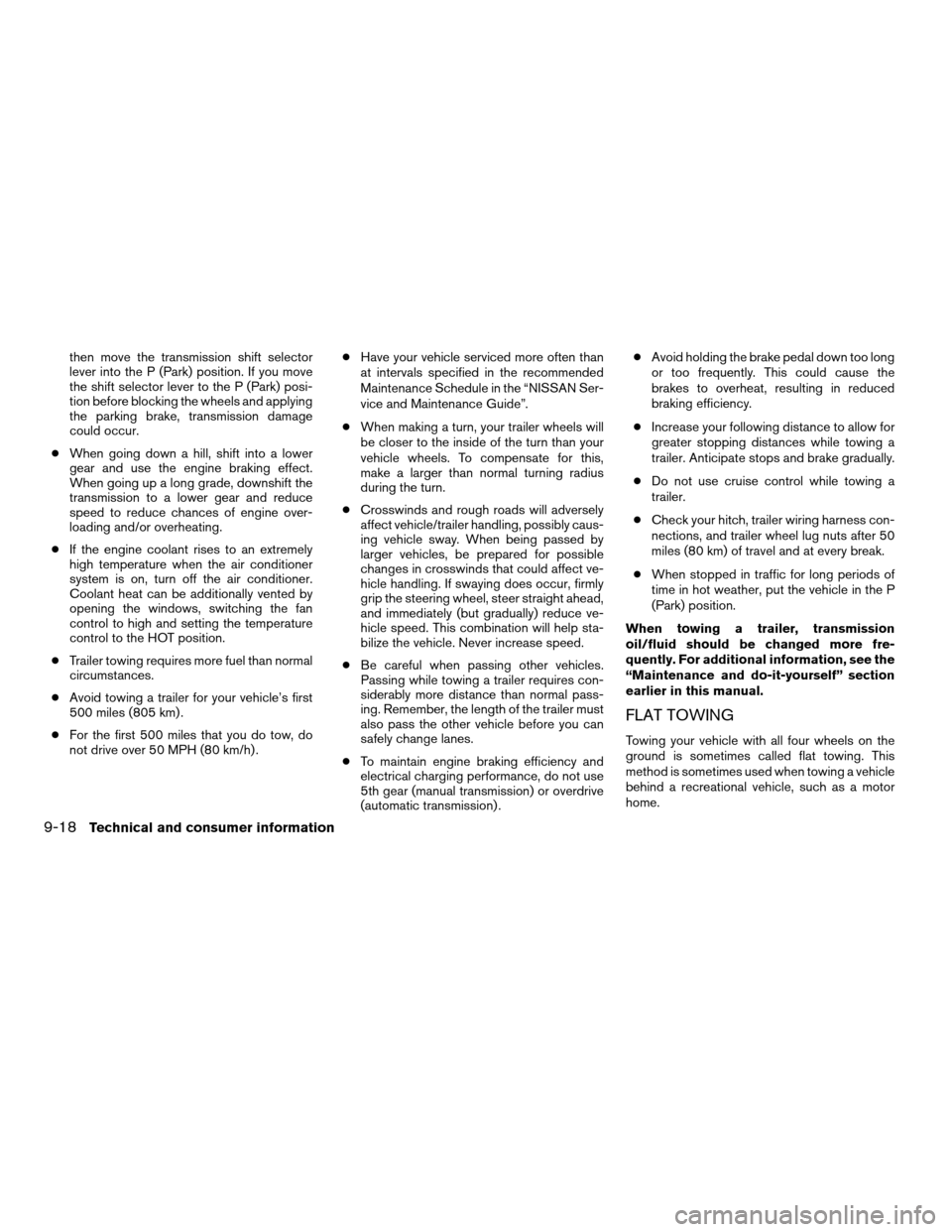
then move the transmission shift selector
lever into the P (Park) position. If you move
the shift selector lever to the P (Park) posi-
tion before blocking the wheels and applying
the parking brake, transmission damage
could occur.
c When going down a hill, shift into a lower
gear and use the engine braking effect.
When going up a long grade, downshift the
transmission to a lower gear and reduce
speed to reduce chances of engine over-
loading and/or overheating.
c If the engine coolant rises to an extremely
high temperature when the air conditioner
system is on, turn off the air conditioner.
Coolant heat can be additionally vented by
opening the windows, switching the fan
control to high and setting the temperature
control to the HOT position.
c Trailer towing requires more fuel than normal
circumstances.
c Avoid towing a trailer for your vehicle’s first
500 miles (805 km) .
c For the first 500 miles that you do tow, do
not drive over 50 MPH (80 km/h) . c
Have your vehicle serviced more often than
at intervals specified in the recommended
Maintenance Schedule in the “NISSAN Ser-
vice and Maintenance Guide”.
c When making a turn, your trailer wheels will
be closer to the inside of the turn than your
vehicle wheels. To compensate for this,
make a larger than normal turning radius
during the turn.
c Crosswinds and rough roads will adversely
affect vehicle/trailer handling, possibly caus-
ing vehicle sway. When being passed by
larger vehicles, be prepared for possible
changes in crosswinds that could affect ve-
hicle handling. If swaying does occur, firmly
grip the steering wheel, steer straight ahead,
and immediately (but gradually) reduce ve-
hicle speed. This combination will help sta-
bilize the vehicle. Never increase speed.
c Be careful when passing other vehicles.
Passing while towing a trailer requires con-
siderably more distance than normal pass-
ing. Remember, the length of the trailer must
also pass the other vehicle before you can
safely change lanes.
c To maintain engine braking efficiency and
electrical charging performance, do not use
5th gear (manual transmission) or overdrive
(automatic transmission) . c
Avoid holding the brake pedal down too long
or too frequently. This could cause the
brakes to overheat, resulting in reduced
braking efficiency.
c Increase your following distance to allow for
greater stopping distances while towing a
trailer. Anticipate stops and brake gradually.
c Do not use cruise control while towing a
trailer.
c Check your hitch, trailer wiring harness con-
nections, and trailer wheel lug nuts after 50
miles (80 km) of travel and at every break.
c When stopped in traffic for long periods of
time in hot weather, put the vehicle in the P
(Park) position.
When towing a trailer, transmission
oil/fluid should be changed more fre-
quently. For additional information, see the
“Maintenance and do-it-yourself” section
earlier in this manual.
FLAT TOWING
Towing your vehicle with all four wheels on the
ground is sometimes called flat towing. This
method is sometimes used when towing a vehicle
behind a recreational vehicle, such as a motor
home.
9-18Technical and consumer information
ZREVIEW COPYÐ2005 Altima (l30)
Owners ManualÐUSA_English (nna)
06/28/04Ðtbrooks
X
Page 291 of 304
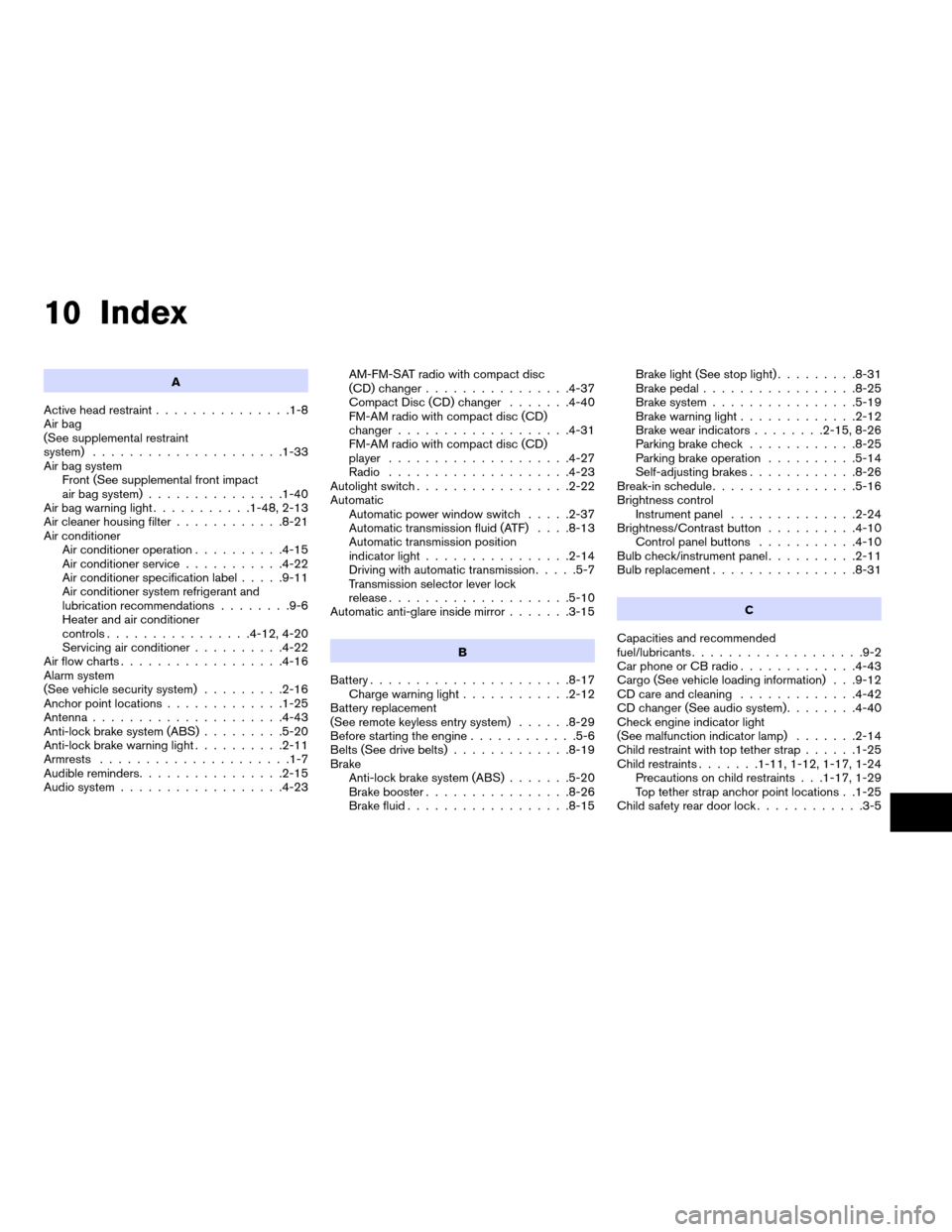
10 Index
A
Active head restraint .............. .1-8
Air bag
(See supplemental restraint
system) .................... .1-33
Air bag system Front (See supplemental front impact
air bag system) .............. .1-40
Air bag warning light ...........1-48, 2-13
Air cleaner housing filter ............8-21
Air conditioner Air conditioner operation ..........4-15
Air conditioner service ...........4-22
Air conditioner specification label .....9-11
Air conditioner system refrigerant and
lubrication recommendations ........9-6
Heater and air conditioner
controls ............... .4-12, 4-20
Servicing air conditioner ..........4-22
Air flow charts ................. .4-16
Alarm system
(See vehicle security system) .........2-16
Anchor point locations .............1-25
Antenna .................... .4-43
Anti-lock brake system (ABS) .........5-20
Anti-lock brake warning light ..........2-11
Armrests .................... .1-7
Audible reminders ............... .2-15
Audio system ................. .4-23AM-FM-SAT radio with compact disc
(CD) changer
............... .4-37
Compact Disc (CD) changer .......4-40
FM-AM radio with compact disc (CD)
changer .................. .4-31
FM-AM radio with compact disc (CD)
player ................... .4-27
Radio ................... .4-23
Autolight switch ................ .2-22
Automatic Automatic power window switch .....2-37
Automatic transmission fluid (ATF) . . . .8-13
Automatic transmission position
indicator light ............... .2-14
Driving with automatic transmission .....5-7
Transmission selector lever lock
release ................... .5-10
Automatic anti-glare inside mirror .......3-15
B
Battery ..................... .8-17
Charge warning light ............2-12
Battery replacement
(See remote keyless entry system) ......8-29
Before starting the engine ............5-6
Belts (See drive belts) .............8-19
Brake Anti-lock brake system (ABS) .......5-20
Brake booster ............... .8-26
Brake fluid ................. .8-15Brake light (See stop light)
.........8-31
Brake pedal ................ .8-25
Brake system ............... .5-19
Brake warning light ............ .2-12
Brake wear indicators ........2-15, 8-26
Parking brake check ............8-25
Parking brake operation ..........5-14
Self-adjusting brakes ............8-26
Break-in schedule ............... .5-16
Brightness control Instrument panel ............. .2-24
Brightness/Contrast button ..........4-10
Control panel buttons ...........4-10
Bulb check/instrument panel ..........2-11
Bulb replacement ............... .8-31
C
Capacities and recommended
fuel/lubricants .................. .9-2
Car phone or CB radio .............4-43
Cargo (See vehicle loading information) . . .9-12
CD care and cleaning .............4-42
CD changer (See audio system) ........4-40
Check engine indicator light
(See malfunction indicator lamp) .......2-14
Child restraint with top tether strap ......1-25
Child restraints .......1-11, 1-12, 1-17, 1-24
Precautions on child restraints . . .1-17, 1-29
Top tether strap anchor point locations . .1-25
Child safety rear door lock ............3-5
ZREVIEW COPYÐ2005 Altima(l30)
Owners ManualÐUSA_English (nna)
07/09/04Ðtbrooks
X
Page 295 of 304
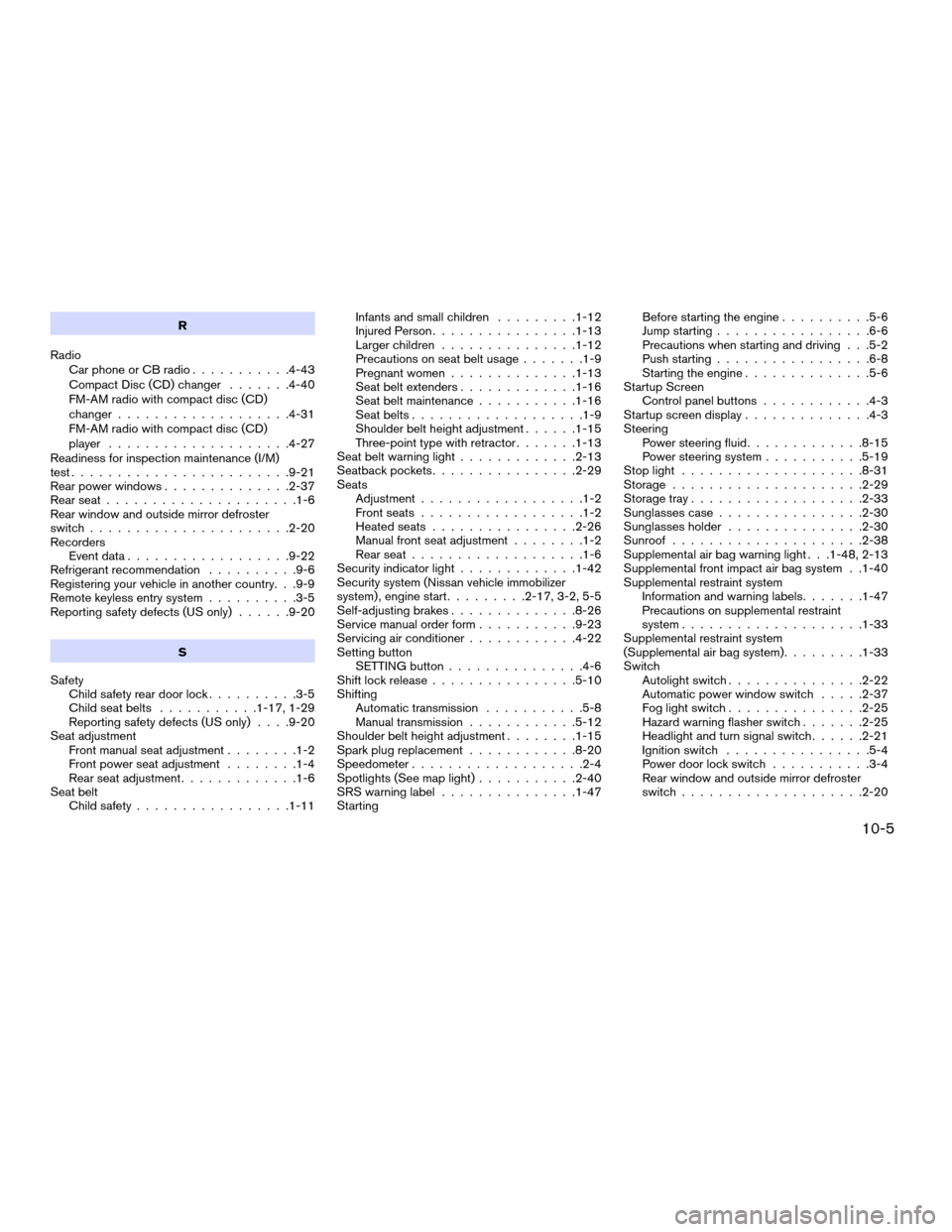
R
Radio Car phone or CB radio ...........4-43
Compact Disc (CD) changer .......4-40
FM-AM radio with compact disc (CD)
changer .................. .4-31
FM-AM radio with compact disc (CD)
player ................... .4-27
Readiness for inspection maintenance (I/M)
test ....................... .9-21
Rear power windows ............. .2-37
Rear seat .................... .1-6
Rear window and outside mirror defroster
switch ..................... .2-20
Recorders Event data ................. .9-22
Refrigerant recommendation ..........9-6
Registering your vehicle in another country. . .9-9
Remote keyless entry system ..........3-5
Reporting safety defects (US only) ......9-20
S
Safety Child safety rear door lock ..........3-5
Child seat belts .......... .1-17, 1-29
Reporting safety defects (US only) . . . .9-20
Seat adjustment Front manual seat adjustment ........1-2
Front power seat adjustment ........1-4
Rear seat adjustment .............1-6
Seat belt Child safety ................ .1-11Infants and small children
.........1-12
Injured Person ............... .1-13
Larger children .............. .1-12
Precautions on seat belt usage .......1-9
Pregnant women ............. .1-13
Seat belt extenders ............ .1-16
Seat belt maintenance ...........1-16
Seat belts .................. .1-9
Shoulder belt height adjustment ......1-15
Three-point type with retractor .......1-13
Seat belt warning light .............2-13
Seatback pockets ............... .2-29
Seats Adjustment ................. .1-2
Front seats ................. .1-2
Heated seats ............... .2-26
Manual front seat adjustment ........1-2
Rear seat .................. .1-6
Security indicator light .............1-42
Security system (Nissan vehicle immobilizer
system) , engine start .........2-17, 3-2, 5-5
Self-adjusting brakes ............. .8-26
Service manual order form ...........9-23
Servicing air conditioner ............4-22
Setting button SETTING button .............. .4-6
Shift lock release ............... .5-10
Shifting Automatic transmission ...........5-8
Manual transmission ............5-12
Shoulder belt height adjustment ........1-15
Spark plug replacement ............8-20
Speedometer .................. .2-4
Spotlights (See map light) ...........2-40
SRS warning label .............. .1-47
Starting Before starting the engine
..........5-6
Jump starting ................ .6-6
Precautions when starting and driving . . .5-2
Push starting ................ .6-8
Starting the engine ............. .5-6
Startup Screen Control panel buttons ............4-3
Startup screen display ..............4-3
Steering Power steering fluid ............ .8-15
Power steering system ...........5-19
Stop light ................... .8-31
Storage .................... .2-29
Storage tray .................. .2-33
Sunglasses case ............... .2-30
Sunglasses holder .............. .2-30
Sunroof .................... .2-38
Supplemental air bag warning light . . .1-48, 2-13
Supplemental front impact air bag system . .1-40
Supplemental restraint system Information and warning labels .......1-47
Precautions on supplemental restraint
system ................... .1-33
Supplemental restraint system
(Supplemental air bag system) .........1-33
Switch Autolight switch .............. .2-22
Automatic power window switch .....2-37
Fog light switch .............. .2-25
Hazard warning flasher switch .......2-25
Headlight and turn signal switch ......2-21
Ignition switch ............... .5-4
Power door lock switch ...........3-4
Rear window and outside mirror defroster
switch ................... .2-20
10-5
ZREVIEW COPYÐ2005 Altima(l30)
Owners ManualÐUSA_English (nna)
07/09/04Ðtbrooks
X